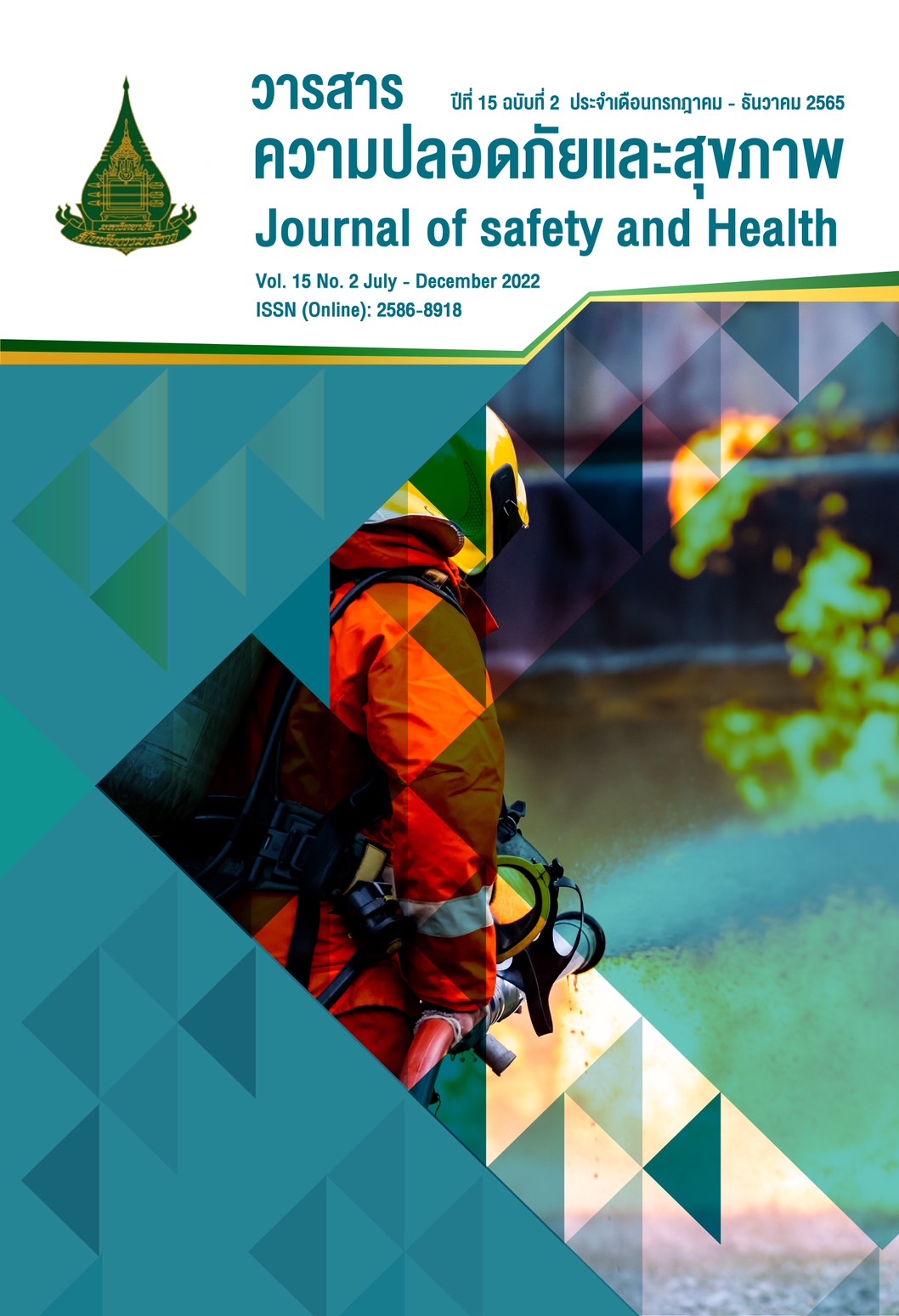ปัจจัยที่มีอิทธิพลต่อการเกิดอาการทางระบบทางเดินหายใจของผู้ประกอบกิจการร้านอาหารและแผงลอยที่ใช้เตาปิ้งย่าง จังหวัดพิษณุโลก
Main Article Content
บทคัดย่อ
การศึกษานี้มีวัตถุประสงค์เพื่อศึกษาอาการทางระบบทางเดินหายใจ และศึกษาปัจจัยที่มีอิทธิพลต่ออาการทางระบบทางเดินหายใจของผู้ประกอบกิจการร้านอาหารและแผงลอยที่ใช้เตาปิ้งย่าง รอบมหาวิทยาลัยแห่งหนึ่งในจังหวัดพิษณุโลก จำนวนทั้งหมด 96 คน ทำการเก็บรวบรวมข้อมูลโดยใช้แบบสอบถาม ประกอบด้วย ข้อมูลส่วนบุคคล ข้อมูลการทำงาน และกลุ่มอาการทางระบบทางเดินหายใจ วิเคราะห์ข้อมูลด้วยสถิติเชิงพรรณนา ได้แก่ ความถี่ ร้อยละ ค่าเฉลี่ย ส่วนเบี่ยงเบนมาตรฐาน ค่าสูงสุด ค่าต่ำสุด สถิติเชิงอนุมาน ได้แก่ วิเคราะห์ถดถอย โลจิสติกแบบทวิ (Binary logistic regression)
ผลการศึกษา พบว่า กลุ่มตัวอย่างส่วนใหญ่เป็นเพศหญิง ร้อยละ 55.2 มีอายุน้อยกว่า 30 ปี ร้อยละ 41.7 ส่วนใหญ่มีประสบการณ์ทำงานขายอาหารปิ้งย่าง 1 – 5 ปี ร้อยละ 59.4 ลักษณะร้านค้าส่วนใหญ่เป็นพื้นที่โล่ง ร้อยละ 78.1 ส่วนใหญ่ใช้เชื้อเพลิงชีวมวลในการประกอบอาหาร ร้อยละ 84.4 ทำงานสัมผัสควันน้อยกว่าหรือเท่ากับ 8 ชั่วโมง ร้อยละ 96.9 กลุ่มตัวอย่างมีอาการทางระบบทางเดินหายใจ ร้อยละ 51 โดยมีอาการ 3 อันดับแรก ได้แก่ ไอ มีเสมหะ และไอร่วมกับมีเสมหะ ปัจจัยที่มีอิทธิพลต่ออาการทางระบบทางเดินหายใจ ได้แก่ เพศ ประสบการณ์การทำงาน ลักษณะของร้านค้า และระยะเวลาในการสัมผัสควัน
เพื่อป้องกันการเกิดอาการระบบทางเดินหายใจ กลุ่มตัวอย่างที่ประกอบอาหารในพื้นที่ปิด ควรใช้วิธีการระบายอากาศด้วยการควบคุมที่แหล่งกำเนิดเพื่อลดการสัมผัสฝุ่นควันจากการเผาไหม้ เช่น การติดตั้งเครื่องดูดควัน และระบายอากาศตามธรรมชาติ เช่น การเปิดประตูและหน้าต่าง
Article Details

อนุญาตภายใต้เงื่อนไข Creative Commons Attribution-NonCommercial-NoDerivatives 4.0 International License.
Journal of Safety and Health is licensed under a Creative Commons Attribution-NonCommercial-NoDerivatives 4.0 International (CC BY-NC-ND 4.0) licence, unless otherwise stated.
เอกสารอ้างอิง
กระทรวงสาธารณสุข. (2561). อัตราการป่วยโรคระบบทางเดินหายใจ. HDC. https://hdcservice.moph.go.th/hdc/reports/report.php?source=envocc/format5.php&cat_id=f16421e617aed29602f9f09d951cce68&id=4408d6d11a1efac662b6fd9e83594cea
กระทรวงสาธารณสุข. (2562). อัตราการป่วยโรคระบบทางเดินหายใจ. HDC. https://hdcservice.moph.go.th/hdc/reports/report.php?source=envocc/format5.php&cat_id=f16421e617aed29602f9f09d951cce68&id=4408d6d11a1efac662b6fd9e83594cea
กระทรวงสาธารณสุข. (2563). อัตราการป่วยโรคระบบทางเดินหายใจ. HDC. https://hdcservice.moph.go.th/hdc/reports/report.php?source=envocc/format5.php&cat_id=f16421e617aed29602f9f09d951cce68&id=4408d6d11a1efac662b6fd9e83594cea
อรทัย เจริญสิทธิ์. (2560). การวิเคราะห์การถดถอยโลจิสติกแบบไบนารีสำหรับการวิจัยทางสังคมศาสตร์. Sau journal of social sciences & humanilities, 1(2), 1-9.
Adewole O.O., Desalu O.O., Nwogu K.C., Adewole T.O., & Erhabor G.E. (2013). Respiratory symptoms and lung function patterns in workers exposed to wood smoke and cooking oil fumes (Mai Suya) in Nigeria. Annals of Medical and Health Sciences Research, 3(1), 38-42.
Awopeju O.F. (2020). Health Effect of Biomass Fuel Smoke. IntechOpen. DOI Object Identifier System Handbook. https://doi.org/10.5772/intechopen.94611
Centers for Disease Control and Prevention. (2017). Smoke and Byproducts of Burning. Center for Disease Control and Prevention. https://www.cdc.gov/niosh/topics/repro/smoke.html
Cochran W.G. (1953). Sampling techniques. John Wiley & Sons.
James B.S., Shetty R.S., Kamath A., & Shetty A. (2020). Household cooking fuel use and its health effects among rural women in southern India-A cross-sectional study. PLOS ONE, 15(4), 1-12. https://doi.org/10.1371/journal.pone.0231757
Juntarawijit C., & Juntarawijit Y. (2017). Cooking smoke and respiratory symptoms of restaurant workers in Thailand. BioMed Central, 17(41), 1-11.
Juntarawijit Y., & Juntarawijit C. (2019). Cooking smoke exposure and respiratory symptoms among those responsible for household cooking: A study in Phitsanulok, Thailand. Heliyon, 1-7. https://doi.org/10.1016/j.heliyon.2019.e01706
Mahembe A., Mkoma S.L., & Kinambo J.L. (2010). Cooking fuels and respiratory symptoms in kitchen workers in Morogoro Municipality, Tanzania. Int. J. Biol. Chem. Sci, 4(4), 976-983.
Nazurah bt Abdul Wahid N. N., Balalla N. P., & Koh D. (2014). Respiratory symptoms of vendors in an open-air hawker center in Brunei Darussalam. Frontiers in Public Health, 2(167), 1-6. http://doi.org/10.3389/fpubh.2014.00167
Saeed A., Abbas M., Manzoor F., & Ali Z. (2015). Assessment of fine particulate matter and gaseous emissions in urban and rural kitchens using different fuels. The Journal of Animal & Plant Science, 25(3 Supp. 2), 687-692.
Svendsen K., Sjaastad A.K., & Sivertsen I. (2003). Respiratory Symptoms in Kitchen Workers. American Journal of Industrial Medicine, 43, 436-439. https://doi.org/10.1002/ajim.10197
Taber K.S. (2018). The use of cronbach’s alpha when developing and reporting research instruments in science education. Res Sci Educ, 48, 1273-1296. https://doi.org/10.1007/s11165-016-9602-2
Venegas A.R., Uncal M. V., Hernandez R. P., Bouilloud N. G., Valencia R. F., Maya M. M., Chavez A. A., & RH S. (2018). Prevalence of COPD and respiratory symptoms associated with biomass smoke exposure in a suburban area. International Journal of COPD, 13, 1727-1734. https://doi.org/10.2147/COPD.S156409
World Health Organization. (2022). Wood Smoke and Your Health. World Health Organization (WHO). https://www.epa.gov/burnwise/wood-smoke-and-your-health#health
World Health Organization. (2022). Household air pollution and health. World Health Organization (WHO). https://www.who.int/news-room/fact-sheets/detail/household-air- pollution-and-health
Wu S. (2021). The health impact of household cooking fuel choice on women: Evidence from China. Sustainability, 13(12080), 1-18. https://doi.org/10.3390/su132112080
Xue Y., Jiang Y., Jin S., & Li Y. (2016). Association between cooking oil fume exposure and lung cancer among Chinese nonsmoking women: a meta-analysis. Dovepress, 2987-2992. https://doi.org/10.2147/OTT.S100949


